
Vaccinium is a common and widespread genus of shrubs or dwarf shrubs in the heath family (Ericaceae). The fruits of many species are eaten by humans and some are of commercial importance, including the cranberry, blueberry, bilberry (whortleberry), lingonberry (cowberry), and huckleberry. Like many other ericaceous plants, they are generally restricted to acidic soils.
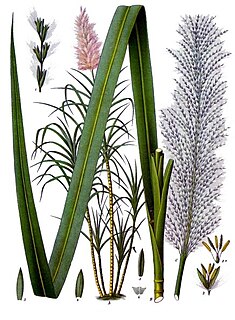
Saccharum is a genus of tall perennial plants of the broomsedge tribe within the grass family.
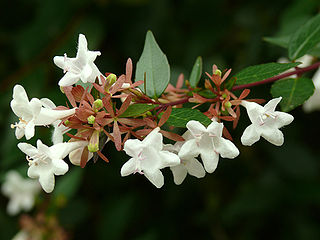
Linnaea × grandiflora, synonym Abelia × grandiflora, is a hybrid species of flowering plant in the honeysuckle family Caprifoliaceae, raised by hybridising L. chinensis with L. uniflora.

Osmanthus is a genus of about 30 species of flowering plants in the family Oleaceae. Most of the species are native to eastern Asia ,and was originally found in middle eastern of Himalayas, with a few species from the Caucasus, New Caledonia, and Sumatra. Osmanthus has been known in China since ancient times with the earliest writings coming from the Warring States period; the book Sea and Mountain. South Mountain states: "Zhaoyao Mountain had a lot of Osmanthus".</ref>

Cotoneaster franchetii is a species of Cotoneaster native to southwestern China, in the provinces of Guizhou, Sichuan, Tibet, and Yunnan, and also in adjacent northern Myanmar and northern Thailand.
Meconopsis villosa, the Himalayan woodland-poppy, is an ornamental poppy, which is native of Nepal. The species was placed in the genus Cathcartia erected by J.D. Hooker to honour J.F. Cathcart, an Indian civil servant and amateur botanist who collected and hired native artists to illustrate the flowers of the Himalayas. It was transferred to Meconopsis by George Taylor in 1934. In 2017, it was suggested that the genus Cathcartia should be revived, and this species again treated as Cathcartia villosa.

James Sykes Gamble was an English botanist who specialized in the flora of the Indian sub-continent; he became Director of the British Imperial Forest School at Dehradun, and a Fellow of the Royal Society.

Kobresia is a genus of plants in the sedge family. They are sometimes called bog sedges. These perennial sedges are quite similar to Carex species in appearance. The genus is widespread across much of Europe, Asia and North America, with many species native to the Himalayas.

Lilium wallichianum is an Asian species of bulbous plants in the lily family native to the Indian Subcontinent and to Myanmar. It is native to India, as well as Nepal, Bhutan, and Myanmar.

Roscoea australis is a perennial herbaceous plant found in Burma, to the south of all other members of the genus. Most members of the ginger family (Zingiberaceae), to which it belongs, are tropical, but R. australis, like other species of Roscoea, grows in much colder mountainous regions.

Jasminum humile, the Italian jasmine or yellow jasmine, is a species of flowering plant in the family Oleaceae, native to Afghanistan, Tajikistan, Pakistan, Nepal, Burma (Myanmar), the Himalayas and south west China. The species is widely cultivated and reportedly naturalized in Greece, Sicily and the former Yugoslavia.

Rhododendron aganniphum is a species of flowering plant in the heath family Ericaceae, native to Tibet and southwestern China, where it grows at altitudes of 2,700–4,700 m (8,900–15,400 ft). It is a compact evergreen shrub that grows to 1–4 m (3.3–13.1 ft) in height, with thick, leathery leaves that are oblong to elliptic-oblong and 4.5–12 by 2–6 cm in size. The flowers are rose-flushed white with maroon flecks, and often pink streaks.

Vaccinium floribundum, commonly known as mortiño or Andean blueberry, is a slender shrub that grows in the northern Andes in Bolivia, Colombia, Ecuador, Peru and Venezuela at elevations from 1,800 to 3,800 metres. It can reach 2–3 m high or it can be dwarf and prostrate. The plant produces an edible fruit, a round berry that is bluish black and glaucous, that is collected and eaten raw and used in preserves. It is sold at some markets and is used for a dish celebrating the Day of the Dead along with spices and other chopped fruits.
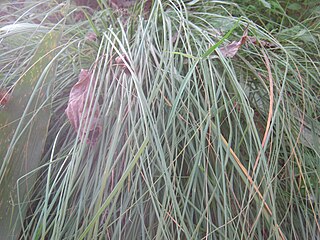
Eulaliopsis binata, the sabaigrass or Chinese alpine rush, is a perennial plant belonging to the grass family that is grown in many Asian countries like China, Nepal, India, Pakistan, Bhutan, Myanmar, Thailand, Malaysia and Philippines.

Androsace sarmentosa, the rock jasmine, is a perennial plant in the family Primulaceae, native to the Himalayas and Tibet. As its synonym Androsace studiosorum it has gained the Royal Horticultural Society's Award of Garden Merit.

Clintonia udensis is a species of flowering plant in the lily family Liliaceae. It is the only species of Clintonia native to Asia. It prefers sparsely forested habitat including the alpine forests of the Himalayas.
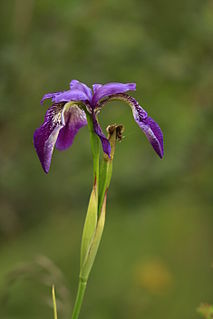
Iris clarkei is a species in the genus Iris, also the subgenus of Limniris and in the series Sibiricae. It is a rhizomatous herbaceous perennial, from Asia, including north east India, Nepal, Tibet, Bhutan, Burma and in China. It has grey-green leaves, long and thin green stem and violet, to dark blue, to blue or reddish purple flowers.
Vaccinium glaucoalbum, the grey-white blueberry, is a species of Vaccinium native to Nepal, east Himalaya, and Myanmar, and Tibet and Yunnan in China. An evergreen shrub with white-bloomed black berries, it has gained the Royal Horticultural Society's Award of Garden Merit as an ornamental. Local people collect and eat the fruit.

Rhododendron anthopogon, the dwarf rhododendron, is a species of flowering plant in the family Ericaceae, native to Pakistan, the Himalayas, Tibet, and Myanmar. It is used to make an essential oil. Its habitats include open slopes, thickets, hillsides, and cliff ledges.
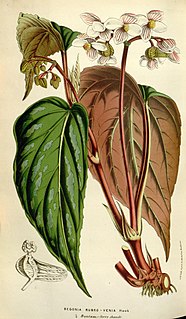
Begonia hatacoa is a species of flowering plant in the family Begoniaceae, native to Tibet, Nepal, the eastern Himalayas, Assam, Bangladesh, Myanmar, Thailand, and Vietnam. Its best-known cultivar is 'Silver'.

















